Snowy owl
| Snowy owl Temporal range: [1]
| |
|---|---|

| |
| Scientific classification | |
| Domain: | Eukaryota |
| Kingdom: | Animalia |
| Phylum: | Chordata |
| Class: | Aves |
| Order: | Strigiformes |
| Family: | Strigidae |
| Genus: | Bubo |
| Species: | B. scandiacus
|
| Binomial name | |
| Bubo scandiacus | |

| |
Breeding Non Breeding | |
| Synonyms | |
| |
The snowy owl (Bubo scandiacus),
Most owls sleep during the day and hunt at night, but the snowy owl is often active during the day, especially in the summertime.[7] The snowy owl is both a specialized and generalist hunter. Its breeding efforts and global population are closely tied to the availability of tundra-dwelling lemmings, but in the non-breeding season, and occasionally during breeding, the snowy owl can adapt to almost any available prey – most often other small mammals and northerly water birds, as well as, opportunistically, carrion.[5][8] Snowy owls typically nest on a small rise on the ground of the tundra.[10] The snowy owl lays a very large clutch of eggs, often from about 5 to 11, with the laying and hatching of eggs considerably staggered.[8] Despite the short Arctic summer, the development of the young takes a relatively long time and independence is sought in autumn.[7]
The snowy owl is a nomadic bird, rarely breeding at the same locations or with the same mates on an annual basis and often not breeding at all if prey is unavailable.
Taxonomy
The snowy owl was one of the many bird species originally described by Carl Linnaeus in his landmark 1758 10th edition of Systema Naturae, where it was given the binomial name Strix scandiaca.[14] The genus name Bubo is Latin for "horned owl" and scandiacus is Neo-Latin for "of Scandinavia".[15] The former generic name Nyctea is derived from Greek meaning "night".[5] Linnaeus originally described the different plumages of this owl as separate species, with the male specimens of snowy owls being considered Strix scandiaca and the likely females considered as Strix nyctea.[5][16] Until recently, the snowy owl was regarded as the sole member of a distinct genus, as Nyctea scandiaca, but mtDNA cytochrome b sequence data shows that it is very closely related to the horned owls in the genus Bubo and the species is now thusly often considered inclusive with that genus.[17][18] However, some authorities debate this classification, still preferring Nyctea. Often authorities are motivated to retain the separate genus on the grounds of osteological distinctions.[5][19]
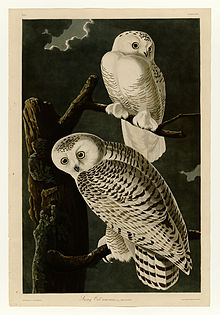
Genetic testing revealed a reasonably distinct genetic makeup for snowy owls, being about 8% genetically distinct from other Bubo owls, perhaps giving credence to those who count the species as separate under Nyctea.
The
Hybrids
Snowy owls are not known to interbreed with other owl species in the wild, and accordingly, no hybrids of snowy owls and other owl species have yet been sighted in the wild. However, a hobby falconer in Kollnburg, Germany, bred hybrids from a male snowy owl and a female Eurasian eagle-owl (Bubo bubo) in 2013.[34] The two resulting male hybrid owls possessed the prominent ear-tufts (generally absent in snowy owls), general size, orange eyes, and the same pattern of black markings on their plumage from their Eurasian eagle-owl mother, while retaining the generally black-and-white plumage colours from their snowy owl father. The hybrids were dubbed "Schnuhus" from the German words for snowy owl and Eurasian eagle-owl (Schnee-Eule and Uhu, respectively). As of 2014, the hybrids had grown to maturity and were healthy.[34]
Description
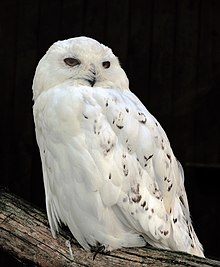
The snowy owl is mostly white. They are purer white than predatory mammals like polar bears (Ursus maritimus) and Arctic fox (Vulpes lagopus).[10] Often when seen in the field, these owls can resemble a pale rock or a lump of snow on the ground.[10] It usually appears to lack ear tufts but very short (and probably vestigial) tufts can be erected in some situations, perhaps most frequently by the female when she is sitting on the nest.[6] The ear tufts measure about 20 to 25 mm (0.79 to 0.98 in) and consist of about 10 small feathers.[7] The snowy owl has bright yellow eyes.[8] The head is relatively small and, even for the relatively simply adapted hearing mechanism of a Bubo owl, the facial disc is shallow and the ear is uncomplicated.[6][7] 1 male had ear slits of merely 21 mm × 14 mm (0.83 in × 0.55 in) on left and 21 mm × 14.5 mm (0.83 in × 0.57 in) on the right.[7] Females are almost invariably more duskily patterned than like-age males.[6][8] In mature males, the upper parts are plain white with usually a few dark spots on the miniature ear-tufts, about the head and the tips of some primaries and secondaries whilst the underside is often pure white.[6] Despite their reputation for being purely white, only 3 out of 129 Russian museum specimens of adult males showed an almost complete absence of darker spots. The adult female is usually considerably more spotted and often slightly barred with dark brown on the crown and the underparts. Her flight and tail feathers are faintly barred brown while the underparts are white in base color with brown spotting and barring on the flanks and upper breast.[6] In confusingly plumaged snowy owls, the sex can be determined by the shape of wing markings, which manifest as bars more so in females and spots in males.[5][35] However, the very darkest males and the lightest females are nearly indistinguishable by plumage.[5] On rare occasion, a female can appear almost pure white, as has been recorded in both the field and in captivity.[36] There is some evidence that some of the species grow paler with age after maturity.[8][37] One study's conclusions were that males were usually but not always lighter and that correctly aging is extremely difficult, sometimes individuals either get lighter, darker or do not change their appearance with age.[36] On the other hand, with close study, it is possible to visually identify even individual snowy owls using the pattern of markings on the wing, which can be somewhat unique in each individual.[38] After a fresh moult, some adult females that previously appeared relatively pale newly evidenced dark, heavy markings. On the contrary, some banded individuals over at least four years were observed to have been almost entirely unchanged in the extent of their markings.[5][8] In another very pale owl, the barn owl (Tyto alba), the sexual dimorphism of spotting appears to be driven by genetics while, in snowy owls, environment may be the dictating factor instead.[5][39]
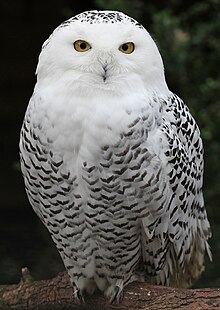
The chicks are initially grayish white but quickly transition to dark gray-brown in the mesoptile plumage. This type of plumage camouflages effectively against the variously colored lichens that dot the tundra ground.[6][8] This is gradually replaced by plumage showing dark barring on white. At the point of fledging, the plumage often becomes irregularly mottled or blotched with dark and is mostly solidly dark gray-brown above with white eyebrows and other areas of the face white.[6] Recently fledged young can already be sexed to a semi-reliable degree by the dark marking patterns about their wings.[40] The juvenile plumage resembles that of adult females but averages slightly darker on average.[8] By their second moult fewer or more broken bars are usually evidenced on the wing. The extent of white and composition of wing patterns become more dimorphic by sex with each juvenile moult, culminating in the 4th or 5th pre-basic moult, wherein the owls are hard to distinguish from mature adults.[5][8][9][40][41] Moults usually occur from July and September, non-breeding birds moulting later and more extensively, and are never extensive enough to render the owls flightless.[5] Evidence indicates that snowy owls may attain adult plumage at 3 to 4 years of age, but fragmentary information suggests that some males are not fully mature and/or as fully white in plumage that they can attain until the 9th or 10th year.[8][40][42] Generally speaking, moults of snowy owls occur more quickly than do those of Eurasian eagle-owls.[9]
The toes of the snowy owl are extremely thickly feathered white, while the claws are black.
Size
The snowy owl is a very large owl.
Male snowy owls have been known to measure from 52.5 to 64 cm (20.7 to 25.2 in) in total length, with an average from four large samples of 58.7 cm (23.1 in) and a maximum length, perhaps in need of verification, of reportedly 70.7 cm (27.8 in).[63][64][65][66] In wingspan, males may range from 116 to 165.6 cm (3 ft 10 in to 5 ft 5 in), with a mean of 146.6 cm (4 ft 10 in).[37][63][65][66] In females, total length has been known to range from 54 to 71 cm (21 to 28 in), with a mean of 63.7 cm (25.1 in) and an unverified maximum length of perhaps 76.7 cm (30.2 in) (if so they would have the second longest maximum length of any living owl, after only the great grey owl).[63][64][65][66] Female wingspans have reportedly measured from 146 to 183 cm (4 ft 9 in to 6 ft 0 in), with a mean of 159 cm (5 ft 3 in).[63][65][66] Despite one study claiming that snowy owl had the highest wing loading (i.e. grams per square cm of wing area) of any of 15 well-known owl species, more extensive sampling demonstratively illustrated that the wing loading of snowy owls is notably lower than Eurasian eagle- and great horned owls.[26] The conspicuously long-winged profile of a flying snowy owl compared to these related species may cause some to compare their flight profile to a bulkier version of an enormous Buteo or a large falcon.[5] Body mass in males can average from 1,465 to 1,808.3 g (3.230 to 3.987 lb), with a median of 1,658.2 g (3.656 lb) and a full weight range of 1,300 to 2,500 g (2.9 to 5.5 lb) from six sources.[6][37][63][65][66][67][68] Body mass in females can average from 1,706.7 to 2,426 g (3.763 to 5.348 lb), with a median of 2,101.8 g (4.634 lb) and a full weight range of 1,330 to 2,951 g (2.932 to 6.506 lb).[37][63][65][66][67][68][69] Larger than the aforementioned body mass studies, a massive pooled dataset at six wintering sites in North America showed that 995 males averaged at 1,636 g (3.607 lb) while 1,189 females were found to average 2,109 g (4.650 lb).[8][70][71] Reported weights of down to 710 g (1.57 lb) for males and of 780 to 1,185 g (1.720 to 2.612 lb) for females are probably in reference to owls in a state of starvation.[6][5][72] Such emaciated individuals are known to highly impaired and starvation deaths are probably not infrequent in winters with poor food accesses.[5][72]

Standard measurements have been even more widely reported than length and wingspan.
Identification
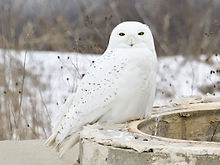
The snowy owl is certainly one of the most unmistakable owls (or perhaps even animals) in the world.[7][10] No other species attains the signature white stippled sparsely with black-brown color of these birds, a coloring which renders their bright yellow eyes all the more detectable, nor possesses their obvious extremely long feathering.[6] The only other owl to breed in the High Arctic is the short-eared owl (Asio flammeus). Both species inhabit open country, overlap in range and are often seen by day, but the short-eared is much smaller and more tan or straw-colored in coloration, with streaked brown on chest. Even the palest short-eared owls conspicuously differ and are darker than the snowy owl; additionally the short-eared most often hunts in extended flights.[8][74] More similar owls such as the Eurasian eagle-owl and the great horned owl attain a fairly pale, sometimes white-washed look in their northernmost races. These species do not normally breed nearly as far north as snowy owls but overlaps certainly do occur when snowy owls when the latter owl sometimes comes south in winter. However, even the most pale great horned and Eurasian eagle-owls are still considerably more heavily marked with darker base colors than snowy owls (the whitest eagle-owls are paler than the whitest great horned owls), possess much larger and more conspicuous ear tufts and lack the bicolored appearance of the darkest snowy owls. While the great horned owl has yellow eyes like the snowy owl, the Eurasian eagle-owl tends to have bright orange eyes. The open terrain habitats normally used by wintering snowy owls are also distinct from the typical edge and rocky habitats usually favored by the great horned and Eurasian eagle-owls, respectively.[6][75][74]
Vocalizations
The snowy owl differ in their calls from other Bubo owls, with a much more barking quality to their version of a hooting song.[10] Perhaps as many as 15 different calls by mature snowy owls have been documented.[76][77] The main vocalization is a monotonous sequence that normally contains 2–6 (but occasionally more), rough notes similar to the rhythm of a barking dog: krooh krooh krooh krooh...[6] The call may end with an emphatic aaoow, which is somewhat reminiscent of the deep alarm call of a great black-backed gull (Larus marinus).[7] They will call mainly from a perch but also sometimes do so in flight.[6] The krooh call of the male snowy owl may perform multiple functions such as competitive exclusion of other males and advertising to females.[8][78] The calls of this species may carry exceptionally far in the thin air of Arctic, certainly over more than 3 km (1.9 mi), and maybe even to as much 10 to 11 km (6.2 to 6.8 mi) away.[7][12] The female has a similar call to male but can be higher-pitched and/or more guttural as well as single notes which are often disyllabic, khuso.[6] Female snowy owls have also been known to utter chirps and high screaming notes, similar to those of the nestlings.[6] Both sexes may at times give a series of clucking, squeals, grunts, hisses and cackles, perhaps such as in circumstances when they are excited.[6][7][8][79] The alarm call is a loud, grating, hoarse keeea.[7] Another raspier bark is recorded, sometimes called a "watchman's rattle" call, and may be transcribed as rick, rick, rick, ha, how, quack, quock or kre, kre, kre, kre, kre.[80] A female attacking to protect her nest was recorded to let out a crowed ca-ca-oh call, whilst other owls attacking to protect the nest did a loud version of the typical call while circling before dropping down.[78][80] They may also clap their beak in response to threats or annoyances. While called clapping, it is believed this sound may actually be a clicking of the tongue, not the beak. Though largely only vocal in the breeding season, leading to some erroneous older accounts describing the snowy owl as completely silent, some vocalizations have been recorded in winter in the northern United States.[76] Initially, the young of the snowy owl have a high pitched and soft begging call which develops into a strong, wheezy scream at around 2 weeks. At the point when the young owls leave the nest around 3 weeks, the shrill squeals they emit may allow the mothers to locate them.[64][79]

Distribution and habitat
Breeding range
The snowy owl is typically found in the northern circumpolar region, where it makes its summer home north of
Between 1967
They also range in much of northern Russia, including northern
In North America, the breeding range has been known in modern times to include the
Regular wintering range
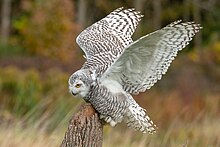
During the winter months, many snowy owls leave the dark Arctic to migrate to regions further south. Southern limits of the regular winter range are difficult to delineate given the inconsistency of appearances south of the Arctic.
Irruptive range
Large winter irruptions at temperate latitudes are thought to be due to good breeding conditions resulting in more juvenile migrants.
Habitat
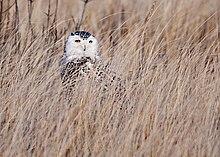
Snowy owls are one of the best known inhabitants of the open Arctic
Behavior
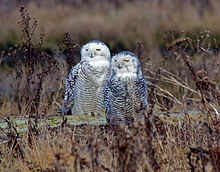
Snowy owls may be active to some extent at both day, from dawn to dusk, and night.
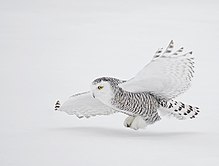
Snowy owls will fight with conspecifics in all seasons occasionally but this is relatively infrequent during breeding and rarer still during winter. Dogfights and talon interlocking may ensue if the fight between two snowy owls continues to escalate.
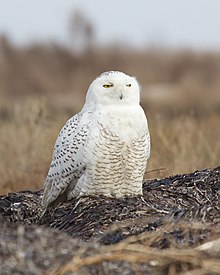
Migration
It is fair to say that the snowy owl is a partial, if fairly irregular,
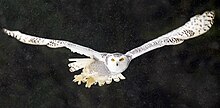
In no fewer than 24 winters between 1882 and 1988, large numbers have occurred in Canada and the United States. These were irruption years.[7] Record breeding irruptive years were recorded in the winters of 2011–2012 and 2014–2015.[8] In the 1940s, it was calculated that the mean gape in time between large irruptions was 3.9 years.[95] Southbound movements as such are much more conspicuous after peak vole years, once thought to be separated by periods of around 3–7 years.[7][137][138][139] However, more extensive research has weakened the argument that irruptions are entirely food-based and the data indicates that irruptive movements are far from predictable. This is because a statewide survey in Alaska found no statewide synchrony in lemming numbers. Therefore, rather than decline of lemmings, it is the successful productivity of several pairs that plays the role, resulting in a large number of young owls that then irrupt. However, the snowy owls cannot breed in high numbers unless lemmings are widely available on the tundra.[8][107][140][141][142] This connection of irruptions to high years of productivity was confirmed in a study by Robillard et al. (2016).[143] About 90% of the snowy owls seen in irruptive years from 1991 to 2016 that were ageable were identified as juveniles.[98]
Diet and Hunting
Hunting techniques
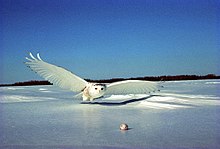
Snowy owls may hunt at nearly any time of the day or night, but may not attempt to do so during particularly severe weather.
Snowy owls may not infrequently exploit prey inadvertently provided or compromised by human activities, including ducks injured by
Prey spectrum

The snowy owl is primarily a hunter of
Summer diet
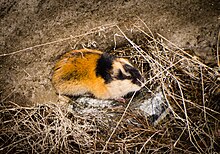
The snowy owl's biology is closely tied to the availability of
In some areas, snowy owls can breed where lemmings are uncommon to essentially absent.
Bird predation by nesting snowy owls is highly opportunistic.
Winter diet
On the wintering grounds, mammals often predominate in the snowy owl's food inland doing so less in coastal areas. Overall wintering snowy owls eat more diverse foods they do whilst breeding, furthermore coastal wintering snowy owls had more diverse diets than inland ones.
During winter, snowy owls consume more strongly nocturnal prey than lemmings such as
On the isle of
While most of the prey species are relatively small, snowy owls can prey on a fairly diverse size of birds and mammals. Data from the
Interspecific predatory relationships
The snowy owl is in many ways a very unique owl and differs from other species of owl in its ecological niche.[7][146] Only one other owl, the short-eared owl, is known to breed in the High Arctic.[7] However, the snowy owl shares its primary prey, the brown and collared lemmings, with a number of other avian predators. In sometimes differing parts of the Arctic, competing predators for lemmings are, in addition to short-eared owls, pomarine jaegers (Stercorarius pomarinus), long-tailed jaegers (Stercorarius longicaudus), rough-legged buzzards (Buteo lagopus), hen harriers (Circus cyaenus), northern harriers (Circus hudsonius) and generally less specialized gyrfalcons (Falco rusticollis), peregrine falcons (Falco peregrinus), glaucous gulls (Larus hypoboreus) and common ravens (Corvus corax). Certain carnivorous mammals, especially the Arctic fox and, in this region, the ermine, are also specialized to hunt lemmings.[7][72][206][207] Most of the lemming predators are intolerant of the competition given the scattered nature of lemming populations and will displace and/or kill one another given the chance. However, given the need to conserve energy in the extreme environment, the predators may react passively to one another.[208][201] When unusually breeding south in the Subarctic such as western Alaska, Scandinavia and central Russia, the number of predators with which the snowy owls are obligated to share prey and compete with may be too numerous to name.[5] The taking of the young and eggs of snowy owls has been committed by a large number of predators: hawks and eagles, the northern jaegers, peregrine and gyrfalcons, glaucous gulls, common ravens, Arctic wolves (Canis lupus arctos), polar bears, brown bears (Ursus arctos), wolverines (Gulo gulo) and perhaps especially the Arctic fox.[8][78] Adult snowy owls on the breeding grounds are far less vulnerable and can be justifiably qualified as an apex predator.[6][7] Instances of the killing of adult snowy owls on the breeding grounds have been witnessed to be committed by a pair of pomarine jaegers on an incubating adult female snowy owl (possibly merely a competitive attack as she was left uneaten) and by an Arctic fox that killed an adult male snowy owl.[205]

When it goes south to winter outside of the Arctic, the snowy owl has the potential to interact with a number of additional predators.[7] By necessity, it shares its wintertime diverse prey with a number of formidable predators.[7][8] These are known to include their cousins, the great horned owl and the Eurasian eagle-owl. They are relieved of heavy competition from the related species by differing temporal activity, i.e. being more likely to actively hunt in the daytime, and by habitat, using rather more open (quite often nearly treeless) habitats than them.[5][7] During a study of wintering snowy owls in Saskatchewan, the authors indicated that the snowy owls may avoid areas inhabited and defended by great horned owls. Although they usually occurred here outside of an 800 m (2,600 ft) radius of central great horned owl ranges, they did not avoid the 1,600 m (5,200 ft) radius and different habitat usage may be a dictating factor.[209] Given their mildly slighter size, it is unlikely that great horned owls (unlike the larger eagle-owl) would regularly dominate snowy owls in interactions and either species may give way to others depending on the size and disposition of the owls involved.[5][7] Little study has been undertaken into the trophic competition of snowy owls with other predators during winter and, due to their scarcity, few predators are likely to expel much energy on competitive interactions with them, although many other predators will engage in anti-predator mobbing of snowy owls.[7][8] Largely in winter, snowy owls have been the victim of a number of larger avian predators, though attacks are likely to be singular and rare.[7][8] Instances of predation on snowy owls are known to have been committed several times in winter only by Eurasian eagle-owls.[210] Additionally, golden eagles (Aquila chrysaetos) have been known to prey on snowy owls as well as all northern sea eagles: the bald (Haliaeetus leucocephalus), white-tailed (Haliaeetus albicilla) and Steller's sea eagles (Haliaeetus pelagicus).[8][185][211] Snowy owls are also sometimes killed by birds that are mobbing them. In one instance, a peregrine falcon killed a snowy owl in a stoop after the owl had killed a fledgling falcon.[12][205] Anecdotal reports indicate predation by gyrfalcons (on snowy owls of unknown age and condition) but it was possibly also an act of mobbing.[175] In another, a huge throng of Arctic terns (Sterna paradisaea) relentlessly swarmed and attacked a snowy owl until it met its demise.[212]
Almost certainly more often than being a victim of other predators, snowy owls are known to dominate, kill and feed on a large diversity of other predators.
Breeding
Pair bond and breeding territory
In Utqiaġvik, of 239 recorded breeding attempts, 232 were monogamous, the other 7 social bigamy.[8] On Baffin Island, 1 male bred with 2 females and sired 11 total fledged young.[79] Another case of bigamy was reported in Norway where the 2 females bred to one male were 1.3 km (0.81 mi) apart in nest site location.[113] On Feltar from 1967 to 1975, a male bred with two females, 1 younger and was possibly his own daughter. In the Feltar males first time breeding with both females, he did not bring food to the younger female. However, when older female disappeared the following year, the male and younger female producing 4 young, but disappeared the subsequent year altogether in 1975.[162] There are also unconfirmed cases of polyandry, with 1 female being fed by 2 males. Snowy owls can breed once per year but when food is scarce many do not even attempt to breed.[6][7] Despite frequent wandering in search of food, they generally adhere more so than to a strict breeding season than short-eared owls nesting in the tundra.[7] 9 radio-tagged female snowy owls about Bylot Island were tracked to study how pre-laying snow cover effects their searching behavior for breeding area. These tracked females searched an average of 36 days and covered an average of 1,251 km (777 mi). It is thought that the male and female mutually find an attractive breeding spot independently and converge.[216] The breeding territory normally averages about 2.6 km2 (1.0 sq mi) as in both Baffin Island and Ellesmere Island but varies in accordance to abundance of food and density of owls.[6][79] Nesting territories average at Baffin island in the range of 8 to 10 km2 (3.1 to 3.9 sq mi) during poor lemming years.[79] Nesting territories may up to 22 km2 (8.5 sq mi) on Southampton Island and had a mean distance of 4.5 km (2.8 mi) between active nests.[77] In Utqiaġvik, nesting pairs can vary from none to at least 7 and the territories average 5 to 10 km2 (1.9 to 3.9 sq mi), with mean nest distances of 1.5 to 6 km (0.93 to 3.73 mi).[72] In the Norwegian highlands, nesting occurs only at times of plenty distances of 1.2 to 3.7 km (0.75 to 2.30 mi) between nests, averaging 2.1 km (1.3 mi).[113] Males marks territory with singing and display flights and likely always initiates.[79] During the display, he engages in exaggerated wing beats with a shallow undulating and bouncy courtship flight with wings held in a dihedral. He often drops to the ground but then flies again to only glide gently back down. Overall, the flight is somewhat reminiscent of the flight of a moth.[79][72][114][162] Females will answer her mate with her song during courtship.[6] While courting, the male often also carries a lemming in his bill, then bows with cocked tail, similarly as in related owls (seldom displaying some other prey like snow buntings). He then flaps his wings open in an emphatic manner, with the ground display being relatively brief (about 5 minutes). The female may possibly refuse to breed if ritual not performed.[79][78] A possible courtship was engaged in by a male in southern Saskatchewan when a female was sighted.[217] On Southampton Island, at least 20 males observed in late May in a "lemming year".[7][77] Nesting territory defense displays, not highly different from courtship displays, includes undulating flight and stiffly raised wings with bouts of exaggerated, delayed wing beats, looking like enormous white moths exposing their white wings under the sun.[78] At times, competing males will interlock claws in mid-air.[7] Territorial and nuptial displays are followed by a ground display by the male with the wings arched up in an "angel" posture, visible for well over a mile.[7]
Nest sites
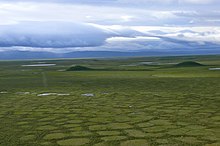
Most individuals arrive at the nest site by April or May with a few overwintering arctic exceptions.
Eggs
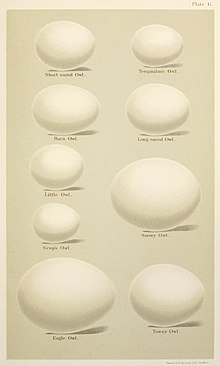
Egg-laying normally begins during early May to the first 10 days of June.
Parental behavior
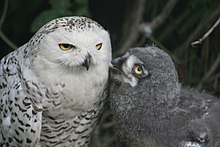
Food is brought to the nest by males and surplus food is stored nearby.
Development of young
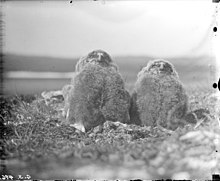
Hatching intervals are generally from 1 to 3 days, quite often within 37–45 hours apart.
Maturity and nesting success

Sexual maturity reached the following year but the first breeding is normally at no sooner than the end of the second year of life.[6] There is little strong evidence of typical age of first breeding but initial breeding by males could be inferred by the plumage of males in Utqiaġvik by plumage. At that stage, which the males were essentially all pure white, most were aged to about 3 to 4 years old.[8] The snowy owl seems to markedly inconsistent in regard to breeding every year, often taking at least up to two years between attempts and sometimes as much as nearly a decade.[5] 7 satellite-marking females in Canada proved that they did breed in consecutive years, with 1 breeding over 3 consecutive years.[97] In 23 years at Utqiaġvik, snowys bred in 13 of them.[8] Nesting success can reach 90–100% in even the largest clutches in high lemming years.[7] While over the course of 21 years, 260 total nests were recorded in Utqiaġvik. There, from 4–54 nests were recorded annually. The Utqiaġvik nests bore 3 to 10 sized-clutches with a mean of 6 eggs per nest and an annual mean hatching success from 39 to 91%. 31–87% of chicks were able to depart on foot and 48–65% were annually estimated to survive to fledge; elsewhere, 40% survived to fledge.[8][64] In another set, 97% of observed eggs both hatched and fledged.[79] In Norway, the fledging success from 10 nests was much lower at about 46%.[113] Norwegian data, which previously indicated it to be an almost accidental breeder in northern Norway, indicates that it is a more regular breeder than expected, though. 3 good years were found for snowy owls between 1968 and 2005: 1974 (when there were 12 pairs), 1978 (22 pairs) and 1985 (20 pairs), with 14 additional locations when potential (but not confirmed) breeding has occurred. The main determinable causes of nest failure were deemed to be starvation and exposure.[8] A number of Norwegian and Finnish nests were known to fail due to severe black fly parasitism.[235]
Longevity
The snowy owl can live a long life for a bird.
Status
This species presence and numbers is dependent on amount of food available. In "lemming years", snowy owls can appear to be quite abundant in habitat.
Anthropogenic mortality and persecution
Of 438 band encounters in the USG banding laboratory, almost all causes of death that could be determined, whether intentional or not, were correlated with human interference.
Snowy owls can be quite wary, as they are not infrequently hunted by Circumpolar peoples.[7] Historically, the snowy owl was one of the most persecuted owl species.[8] In the irruption of 1876–77, an estimated 500 snowy owls were shot, with similar numbers in 1889–90 and an estimated 500–1,000 killed in Ontario alone during 1901–02 invasion and about 800 killed in the 1905–06 invasion.[12] Indigenous people of the Arctic historically killed snowy owls as food but now many communities in northern Alaska are fairly modernized, therefore biologists feel that the permitted killing of snowy owls by the indigenous is outdated.[8][265] The consumption of snowy owls by humans has been proven as far back as ancient cave deposits in France and elsewhere, and they have even been considered as one of the most frequent food species for early humans.[266][267] They do not shun developed areas especially with old field that hold rodents and, due to lack of human experience, can be extremely tame and unable to escape armed humans.[7] In British Columbia, of 177 snowy owl deaths, the most often diagnosed cause of death was shootings at 25%, often well after legal protection of the species.[185] The number poached snowy owls in Ontario is opined to be unusually high considering their scarcity.[268] While the species was once otherwise killed as food and then later shot out of resentment for perceived threats against domestic and favored game stock, the reasoning behind ongoing shooting of snowy owls into the 21st century is not well-understood.[8][167][268] Siberian snowy owls are frequently victim to baited fox traps, with possibly up to around 300 killed in a year based upon very rough estimates.[269] Warfarin poisoning in use as rodenticides are known to kill some wintering snowy owls, including up to six at Logan Airport alone.[185][270] Mercury concentrations, most likely through bioaccumulation, have been detected in snowy owls in the Aleutian Islands but it is not known whether fatal mercury poisoning has occurred.[271] PCBs may have killed some snowy owls in concentration.[175] Some airports have advocated and instituted the practice of shooting owls to avoid birdstrikes but successful translocation is possible and preferred given the species protected status.[8][263]
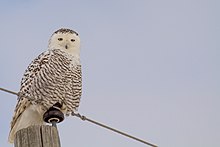
In popular culture
- The Harry Potter books by J. K. Rowling, and subsequent films of the same name, feature a female snowy owl named Hedwig.[275] Concern was expressed by some in the media that the popularity of the Harry Potter films would cause an increase in the illicit owl trade of snowy owls. However, there was no strong evidence of an increase in snowy owls confiscated from the black market, despite a larger than typical number of snowy owls being reported at wildlife centres.[276]
- The snowy owl (harfang des neiges in French) is the avian symbol of Quebec.[277]
References
- ^ "Bubo scandiacus Linnaeus 1758 (snowy owl)". PBDB.
- ^ . Retrieved 19 November 2021.
- ^ a b "Appendice". CITES. Retrieved 14 January 2022.
- ^ Lewis, Deane (4 July 2022). "Snowy Owl ~ Bubo scandiacus (Nyctea scandiaca)". The Owl Pages. Retrieved 30 December 2022.
- ^ ISBN 978-0713688177.
- ^ ISBN 9781408108840.
- ^ ISBN 978-0-00-219493-8.
- ^ .
- ^ hdl:11250/2454504.
- ^ a b c d e f g h i j k l m n o p Hume, R. (1991). Owls of the world. Running Press, Philadelphia.
- ^ Sindelar Jr., C. (1966). "A comparison of five consecutive Snowy Owl invasions in Wisconsin". Passenger Pigeon. 28 (10): 108.
- ^ a b c d e f g h i j k Bent, A. C. (1938). Life Histories of North American Birds of Prey (part 2), Orders Falconiformes and Stringiformes (Vol. 170). US Government Printing Office.
- ^ S2CID 6706626.
- ^ Linnaeus, Carl (1758). Systema Naturae per Regna Tria Naturae, Secundum Classes, Ordines, Genera, Species, cum Characteribus, Differentiis, Synonymis, Locis. Tomus I. Editio decima, reformata (in Latin). Holmiae: (Laurentii Salvii). p. 92.
- ISBN 978-1-4081-2501-4.
- .
- ^ Wink, M. & Heidrich, P. (2000). "Molecular systematics of owls (Strigiformes) based on DNA-sequences of the mitochondrial cytochrome b gene", pp. 819–828 in: Chancellor, R.D. & Meyburg, B.U. eds. (2000). Raptors at Risk. Proceedings of the V World Conference on Birds of Prey and Owls. Midrand, Johannesburg, 4–11 August 1998. WWGBP & Hancock House, Berlin & Blaine, Washington.
- ^ Penhallurick, J. M. (2002). "The taxonomy and conservation status of the owls of the world: a review". Ecology and conservation of owls. CSIRO, Collingwood, pp. 343–354.
- ^ a b c Ford, N. L. (1967). A systematic study of the owls based on comparative osteology. PhD diss, Univ. of Michigan, Ann Arbor.
- S2CID 7848355.
- ^ S2CID 55406064.
- doi:10.1093/auk/98.4.681 (inactive 31 January 2024).)
{{cite journal}}: CS1 maint: DOI inactive as of January 2024 (link - ISBN 9780124983151.
- S2CID 37933718.
- ^ doi:10.1139/g91-110.
- ^ ISBN 9781770851368
- S2CID 86526031.
- ^ a b Brodkorb, P. (1971). "Catalogue of fossil birds, Part 4 (Columbiformes through Piciformes)". Bulletin of the Florida State Museum, Biological Sciences. 15 (4): 163.
- ^ Stewart, J. R. (2007). "The fossil and archaeological record of the Eagle Owl in Britain" (PDF). British Birds. 100 (8): 481.
- ^ Boev, Z. (1998). "First fossil record of the Snowy Owl Nyctea scandiaca (Linnaeus, 1758) (Aves: Strigidae) from Bulgaria". Historia Naturalis Bulgarica. 9: 79–86.
- ISBN 978-88-8080-025-5.
- ^ Andrews, P. (1990). Owls, caves and fossils. Chicago: University of Chicago Press.
- ^ Marthinsen, G., Wennerberg, L., Solheim, R., & Lifjeld, J. T. (2009). Snowy owls (Bubo scandiacus) constitute one panmictic population. University of Oslo.
- ^ a b "Schnuhu": Überraschende Kreuzung – Ich bin Bayerns süßester Fratz!. tz.de Retrieved on 7 October 2016
- ^ S2CID 257370732.
- ^ a b McMorris, A. (2011). Snowy Owls: Age, Sex and Plumage. Presentation Delaware Valley Ornithological Club.
- ^ a b c d e f Dementiev, G. P., Gladkov, N. A., Ptushenko, E. S., Spangenberg, E. P., & Sudilovskaya, A. M. (1966). Birds of the Soviet Union, vol. 1. Israel Program for Scientific Translations, Jerusalem.
- S2CID 89366804.
- S2CID 23689499.
- ^ S2CID 56119725.
- JSTOR 4089230.
- ^ a b c d e f g h Cramp, S.; Simmons, K.E.L. (1985). Birds of the Western Palearctic. Vol. 2. Oxford: Oxford University Press.
- JSTOR 1367496.
- JSTOR 1362901.
- JSTOR 1363004.
- PMID 28163870.
- JSTOR 4509709.
- S2CID 1633943.
- ^ Gill, F. (2007). Ornithology. 3rd Edn. (W. H. Freeman Co: New York.
- S2CID 19386851.
- S2CID 8401149.
- S2CID 40455349.
- PMID 4446369.
- PMID 24258716.
- S2CID 29148489.
- PMID 12028780.
- ^ a b c d Weidensaul, S. (2015). Owls of North America and the Caribbean. Houghton Mifflin Harcourt.
- ^ ISBN 978-1-4200-6444-5.
- JSTOR 4078421.
- JSTOR 3676862.
- ISBN 978-3-540-39567-6.
- JSTOR 3676820.
- ^ a b c d e f g h i j k Eckert, A. W. (1987). The Owls of North America, North of Mexico: All the Species and Subspecies Illustrated in Color and Fully Described. Gramercy.
- ^ a b c d e f g h i j k l m n o p q r s t u Parmelee, D. F. (1972). Canada's incredible arctic owls. Beaver no. summer:30–41.
- ^ a b c d e f g h i j k l Priklonskiy, S.G. (1993). Snowy Owl — Nyctea scandiaca (Linnaeus, 1758). In: Birds of Russia and adjoining regions: Pterocliformes, Columbiformes, Cuculiformes, Strigiformes. Moscow, p. 258–270. (in Russian).
- ^ doi:10.5962/p.341857.
- ^ JSTOR 1366002.
- ^ a b c d Kerlinger, P.; Lein, M. R. (1988). "Causes of Mortality, Fat Condition, and Weights of Wintering Snowy Owls" (PDF). Journal of Field Ornithology. 59 (1): 7–12.
- ^ National Geographic Society. "Snowy Owl".
- S2CID 88567694.
- ^ S2CID 89118791.
- ^ JSTOR 1364693.
- ^ a b c d Josephson, B. (1980). "Aging and sexing snowy owls" (PDF). Journal of Field Ornithology. 51: 149–160.
- ^ a b Pyle, P. (1997). Identification Guide to North American Birds, Part I: Columbidae to Ploceidae. Slate Creek Press, Bolinas, CA, USA.
- ISBN 978-0811726894.
- ^ a b c Evans, D. L. (1980). "Vocalizations and territorial behavior of wintering Snowy Owls". Am. Birds. 34: 748–749.
- ^ S2CID 164727574.
- ^ a b c d e f Taylor, P.S. (1973). "Breeding behaviour of the Snowy Owl". Living Bird. 12: 137–154.
- ^ .
- ^ JSTOR 1364705.
- .
- ^ Hosking, Eric (2 August 1967). "Snowy Owl with young—an historic photograph". The Times. UK.
- The Shetland News. UK. Retrieved 23 October 2020.
- ^ "Hope of first owl chicks in years", BBC News. 13 May 2008.
- ^ Marquiss, M., Smith, R. & Galbraith, H. (1989). "Diet of Snowy Owls on Cairn Gorm Plateau in 1980 and 1987" (PDF). Scottish Birds. 15 (4): 180–181.
{{cite journal}}: CS1 maint: multiple names: authors list (link) - ^ "Snowy Owl Facts". The Owls Trust. Retrieved 21 December 2023.
- ^ Saxby, H. L. (1863). "Notes on the Snowy Owl". Zoologist. 21: 8633–8639.
- ^ Saurola, P. L. (1997). Monitoring Finnish owls 1982–1996: methods and results. United States Department of Agriculture Forest Service General Technical Report NC, pp. 363–380.
- ^ Mineev, O. Y. & Minnev, Y. N. (2005). Distribution of owls in North-East European tundra. In: Owls of the Northern Eurasia (eds. Volkov S.V., Morozov V.V. & Sharikov A.V.).
- ^ Miller, F.L., Russell, R.H. & Gunn, A. (1975). "Distribution and numbers of Snowy Owls on Melville, Eglinton, and Byam Martin Islands, Northwest Territories, Canada" (PDF). Raptor Research. 9 (3–4): 60–64.
{{cite journal}}: CS1 maint: multiple names: authors list (link) - JSTOR 1366490.
- .
- ^ .
- ^ Conlin, Dan (2 October 2013). "An Owl Oddity", Maritime Museum of the Atlantic.
- ^ JSTOR 4080718.
- .
- ^ S2CID 90013886.
- ^ .
- ^ Root, T. R. (1988). Atlas of Wintering North American Birds: An Analysis of Christmas Bird Count Data. University of Chicago Press, Chicago, IL, USA.
- ^ Robbins, M. B.; Otte, C. (2013). "The irruptive movement of Snowy Owls (Bubo scandiacus) into Kansas and Missouri during the winter of 2011–2012" (PDF). Kansas Ornithological Society Bulletin. 64 (4): 41–44.
- ^ "Snowy Owl Appears in Middle Tennessee." The Styling Owlish. 24 January 2009.[dead link]
- ^ Zuckerman, Laura (28 January 2012). Snowy owls soar south from Arctic in rare mass migration. Reuters
- ^ Leung, Marlene Leung (5 January 2014). "Snowy owl invasion: Birds spotted as far south as Florida". CTV News.
- ^ Schwartz, John (31 January 2014). "A Bird Flies South, and It's News". New York Times. Retrieved 31 January 2014.
- .
- ^ JSTOR 1363262.
- ^ doi:10.1139/z85-273.
- ^ S2CID 4675025.
- doi:10.5962/p.346914.
- JSTOR 3807920.
- ^ Young, C.M. (1973). "The Snowy Owl migration of 1971–72 in the Sudbury region of Ontario" (PDF). American Birds. 27 (1): 11–12.
- ^ JSTOR 3536292.
- ^ a b c d e f Hagen, Y. (1960). The Snowy Owl on Hardangervidda in the Summer of 1959. Papers of The Norwegian State Game Research. 2, No. 7.
- ^ a b c d e f g h i Tulloch, R. J. (1968). "Snowy Owls breeding in Shetland in 1967" (PDF). British Birds. 61: 119–132.
- ^ Boxall, P. C.; Lein, M. R. (1989). "Time budgets and activity of wintering Snowy Owls" (PDF). Journal of Field Ornithology. 60 (1): 20–29.
- ^ "Snowy Owl (Nyctea Scandia)". National Geographic. 11 November 2010. Archived from the original on 6 February 2010.
- JSTOR 1364794.
- ^ Therrien, J. F., Pinaud, D., Gauthier, G., Lecomte, N., Bildstein, K. L., & Bety, J. (2015). Pre-breeding prospecting behaviour of snowy owls (data from Therrien et al. 2015).
- .
- .
- ^ a b Boxall, P.C.; Lein, M.R. (1982). "Are owls regular? An analysis of pellet regurgitation times of Snowy Owls in the wild" (PDF). Raptor Research. 16 (3): 79–82.
- ^ Kaufman, K. (1996). Lives of North American Birds. Houghton Mifflin Company, Boston & New York.
- ^ a b Hart, H. C. (1880). "Notes on the ornithology of the British Polar Expedition, 1875-6". Zoologist. 4: 121–129.
- ^ JSTOR 1943215.
- ^ S2CID 85885670.
- ^ JSTOR 1930558.
- doi:10.5962/p.344363.
- ^ a b c Manning, T. H., Höhn, E. O. & MacPherson, A. H. (1956). The birds of Banks Island. National Museum of Canada Bulletin 143, Biological Series 48.
- ^ Vaughn, R. (1992). In search of Arctic birds. London: T & AD Poyser, Ltd.
- ^ Menyushina, I. E. (1997). "Snowy Owl (Nyctea scandiaca) reproduction in relation to lemming population cycles on Wrangel Island". In: Biology and conservation of owls of the Northern Hemisphere: 2nd International Symposium, J. R. Duncan, D. H. Johnson and T. H. Nicholls (eds.), pp. 572–582. St. Paul: U.S. Dept. of Agriculture, Forest Service, North Central Forest Experiment Station.
- S2CID 90397907.
- ^ Øien, I. J., Aarvak, T., Jacobsen, K. O., & Solheim, R. (2018). "Satellite Telemetry Uncovers Important Wintering Areas for Snowy Owls On the Kola Peninsula, Northwestern Russia". Орнитология, 42, 42–49.
- .
- doi:10.1139/z11-008.
- .
- JSTOR 4157203.
- JSTOR 4079810.
- ^ JSTOR 1527.
- ^ JSTOR 4079593.
- ^ Pitelka, F. A. & Batzli, G. O. (1993). "Distribution, abundance, and habitat use by lemmings on the north slope of Alaska". In: The biology of lemmings, N. C. Stenseth and R. A. Ims (eds.), pp. 213–236. London: Academic Press.
- ^ a b Krebs, C. J. (1993). "Are lemmings large Microtus or small reindeer? A review of lemming cycles after 25 years and future recommendations for future work". In: The biology of lemmings, N. C. Stenseth and R. Ims (eds.), pp. 247–260. London: Academic Press for the Linnean Society of London.
- S2CID 10938486.
- ^ Snowy Owl — Bubo scandiacus, formerly Nyctea scandiaca. owlpages.com
- S2CID 134132621.
- ^ a b Johnsgard, P. A. (1988). North American owls: biology and natural history. Smithsonian Institution.
- doi:10.5962/p.343832.
- ^ Audubon, J. J. (1840). The Birds of America. Dover Publications, Inc., New York, NY, USA.
- ^ Dancey, H.E. (1983). "Winter foraging habits of a Snowy Owl". Indiana Audubon Quarterly. 61 (4): 136–144.
- ^ Duffy, D. C., Beehler B. & Haas, W. (1976). "Snowy Owl steals prey from Marsh Hawk" (PDF). Auk. 93 (4): 839–840.
{{cite journal}}: CS1 maint: multiple names: authors list (link) - ^ .
- ^ Winter, R. E. (2016). Hunting Behaviors and Foraging Success of Winter Irruptive Snowy Owls in New York Archived 16 April 2022 at the Wayback Machine. SUNY College of Environmental Science and Forestry, Thesis.
- ^ JSTOR 4081330.
- ^ Brooks, W. S. (1915). "Notes on birds from east Siberia and Arctic Alaska". Bulletin of the Museum of Comparative Zoology. 59: 361–413.
- ^ Robertson, G. J.; Gilchrist, H. G. (2003). "Wintering Snowy Owls feed on sea ducks in the Belcher Islands, Nunavut, Canada" (PDF). Journal of Raptor Research. 37 (2): 164–166.
- S2CID 207933662.
- ^ S2CID 86573933.
- ^ S2CID 85204849.
- ^ a b "Nyctea scandiaca (Snowy owl)". Animal Diversity Web.
- ^ König, Claus, Friedhelm Weick, and Jan-Hendrik Becking. Owls of the World. 2nd ed. Bloomsbury Publishing, 2009. Web. 23 May. 2023.
- ^ a b Marti, C. D., Korpimäki, E., & Jaksić, F. M. (1993). "Trophic structure of raptor communities: a three-continent comparison and synthesis". In Current ornithology, pp. 47–137. Springer, Boston, MA.
- ^ a b c d e f g h i Robinson, M.; Becker, C.D. (1986). "Snowy Owls on Fetlar" (PDF). British Birds. 79 (5): 228–242.
- ISBN 9780521227766
- JSTOR 1550496.
- ^ doi:10.5962/p.344363.
- ^ a b Krechmar, A.V. & Dorogoy, I.V . (1981). "Snowy Owl (Nyctea scandiaca)". In: Ecology of mammals and birds in Wrangel Island. Vladivostok: DVNZ AN SSSR: pp. 56–81.
- ^ a b Dufresne, F. (1922). "The Snowy Owl-destroyer of game". Bull. Amer. Game Prot. Assoc. 11: 11–12.
- ^ a b c d Hakala, A., Huhtala, K., Kaikusalo, A., Pulliainen, E., & Sulkava, S. (2006). "Diet of Finnish snowy owls Nyctea scandiaca". Ornis Fennica. 83 (2): 59.
{{cite journal}}: CS1 maint: multiple names: authors list (link) - ^ Andersson, N. Å. & Persson, B. (1971). "Något om fjällugglans Nyctea scandiaca näringsval i Lappland". Vår Fågelvärld. 30: 227–231.
{{cite journal}}: CS1 maint: multiple names: authors list (link) - S2CID 83617297.
- ^ Brackney, A. W. & King, R. J. (1991). Population shifts by Snowy Owls on the Arctic coastal plain of Alaska. Abstract. In Alaska Bird Conference and Workshop. Anchorage.
- JSTOR 40511025.
- ^ Potapova, O. (2001). "Snowy owl Nyctea scandiaca (Aves: Strigiformes) in the Pleistocene of the Ural Mountains with notes on its ecology and distribution in the Northern Palearctic". Deinsea. 8 (1): 103–126.
- ^ Tarasov, V. V. (2011). Summer flocks of the Willow Ptarmigan in the north of the Yamal Peninsula. In: R. T. Watson, T. J. Cade, M. Fuller, G. Hunt, and E. Potapov (Eds.). Gyrfalcons and Ptarmigan in a Changing World. The Peregrine Fund, Boise, Idaho, USA.
- ^ a b c d e Heggøy, O., & Øien, I. J. (2014). Conservation status of birds of prey and owls in Norway. NOF/BirdLife Norway-Report, 1, 1–129.
- ^ Dorogoy, I.V . (1987). Ecology of small mammal predators in Wrangel Island and their role in the dynamics of lemming numbers. Vladivostok: DVO AN SSSR. (In Russian).
- .
- ^ S2CID 92610543.
- ^ JSTOR 1367296.
- ^ Krasnov, Y. (1985). To the biology of the Snowy Owl in the Eastern Murman. Birds of Prey and Owls in the Nature Reserves of the Russian Federation. TSNIL GLAVOKHOTA, pp. 110–116.
- ^ Valenziano, R. L.; Labedz, T. E. (September 2014). "Stomach Content Analysis of Recent Snowy Owl (Bubo scandiacus) Specimens from Nebraska". Neb. Bird Review. 80 (3): 122–127.
- S2CID 84091677.
- .
- JSTOR 3800714.
- ^ a b c d e Campbell, R. W.; Preston, M. I. (2009). "Featured Species – Snowy Owl (Bubo scandiacus)". Wildlife Afield. 6 (2): 173–255.
- .
- ^ Keith, L. B. (1963). "A note on Snowy Owl food habits". The Wilson Bulletin. 75 (3): 276–277.
- ^ Chamberlin, M. L. (1980). "Winter hunting behavior of a snowy owl in Michigan" (PDF). The Wilson Bulletin. 92 (1): 116–120.
- JSTOR 3795698.
- ^ a b Young, E.A., Blake, C., Graham, R., Otte, C., Beckman, M. & Klem, D. (2014). "Prey items from Snowy Owl (Bubo scandiacus) Pellets during the 2011–2012 Irruption in Kansas". Kansas Ornithological Society. 65 (4): 33–40.
{{cite journal}}: CS1 maint: multiple names: authors list (link) - ^ Miles, W. T. S., & Money, S. (2008). Behaviour and diet of non-breeding Snowy Owls on St Kilda. Scottish Birds, 28, 11.
- ^ Murrey, T.; Sleeman, D. (2005). "Dietary analysis from the Snowy Owls pellets Nyctea scandiaca Linnaeus 1958, from the Mullet Peninsula, Co, Mayo". Irish Naturalists' Journal. 283: 136.
- ^ a b Savory, J. (2019). "Unpublished information in the SOC Archive on Snowy Owl diet at three locations in Moray in the 1960s". Scottish Birds. 202 (204): 202.
- ^ a b Maleev, V.G. & Popov, V. V. (2007). Birds of forest-steppes of the Upper Angara river basin. Irkutsk.
- ^ Duncan, James R. Owls of the world: their lives, behavior and survival. Firefly Books, 2003.
- .
- ^ Uher-Koch, B. D., M. R. North, and J. A. Schmutz (2020). Yellow-billed Loon (Gavia adamsii), version 1.0. In Birds of the World (S. M. Billerman, Editor). Cornell Lab of Ornithology, Ithaca, NY, USA.
- ^ Nagy, S., Petkov, N., Rees, E., Solokha, A., Hilton, G., Beekman, J., & Nolet, B. (2012). International single species action plan for the conservation of the northwest European population of Bewick's Swan (Cygnus columbianus bewickii). Wetlands International and The Wildfowl & Wetlands Trust (WWT), AEWA Technical Series, (44).
- JSTOR 3504196.
- ^ Bergman, G. (1961). "The food of birds of prey and owls in Fenno-Scandia" (PDF). British Birds. 54 (8): 307–320.
- ^ .
- doi:10.1644/0.713.1.
- .
- ^ Dunning, Jr., J. B. (1993). CRC handbook of avian body masses. CRC Press, Boca Raton, FL.
- ^ a b c Bailey, A. M. (1948). Birds of Arctic Alaska. Colorado Mus. Nat. Hist., Popular Ser., 8.
- JSTOR 3545963.
- ^ Maher, W. J. (1970). "The Pomarine Jaeger as a Brown Lemming predator in northern Alaska" (PDF). Wilson Bulletin. 82: 130–157.
- JSTOR 4314894.)
{{cite journal}}: CS1 maint: multiple names: authors list (link - ^ Chang, A. M. (2017). Habitat use, movement patterns, and body condition of male and female Snowy Owls (Bubo scandiacus) in winter. Doctoral dissertation, University of Saskatchewan.
- ^ a b c d e Mikkola, H. (1976). "Owls killing and killed by other owls and raptors in Europe" (PDF). British Birds. 69: 144–154.
- ^ Johnson, M.J. (1995). "Bald Eagle predation on Snowy Owl". Loon. 67 (2): 107.
- ^ Meinertzhagen, R. (1959). Pirates and Predators: The piratical and predatory habits of birds. Oliver & Boyd.
- JSTOR 1368028.
- JSTOR 3565424.
- .
- PMID 25709836.
- ^ Boxall, P. C.; Lein, M. R. (1982). "Possible courtship behavior of Snowy Owls in winter" (PDF). Wilson Bulletin. 94: 79–81.
- ^ S2CID 85964696.
- JSTOR 4163840.)
{{cite journal}}: CS1 maint: multiple names: authors list (link - doi:10.1139/z96-210.
- S2CID 33917321.
- ^ Smith, P. A. (2003). Factors affecting nest site selection and reproductive success of tundra nesting shorebirds (Doctoral dissertation, University of British Columbia).
- ^ Baicich, P.J. & Harrison, C.J.O. (1997). A Guide to the Nests, Eggs, and Nestlings of North American Birds. Academic Press, San Diego, California.
- ^ Schönwetter, M. (1960). Handbuch der Oologie (Ed. W. ME~SE). Vol. 1. Berlin.
- ^ Bendire, C. E. (1892). Life histories of North American birds with special reference to their breeding habits and eggs. U.S. National Museum Special Bulletin 1.
- ^ a b Schaanning, H. T. L. (1907). Østfinmarkens fuglefauna. Bergens Mus. Arb. 8:1–98.
- ^ Pleske, T. (1928). Birds of the Eurasian tundra. Mem. Boston Soc. Nat. Hist. 6:111–485.
- ^ Parmelee, D. F., Stephens, H. A. & Schmidt, R. H. (1967). The birds of Southeastern Victoria Island and adjacent small islands. National Museum of Canada Bulletin 222.
- ^ Couzens, D. (2008). Extreme Birds: The World's Most Extraordinary and Bizarre Birds. Firefly Books.
- ^ JSTOR 3676252.
- ^ ADW: Nyctea scandiaca: Information. Animaldiversity.ummz.umich.edu. Retrieved on 19 October 2010.
- ^ Romero, L. M., Holt, D. W. Maples M. & Wingfield, J. C.. (2006). Corticosterone is not correlated with nest departure in Snowy Owl chicks (Nyctea scandiaca). General and Comparative Endocrinology 149 (2): 119–123.
- ^ Holt, D. W. & Leasure, S. M. (1993). Short-eared Owl (Asio flammeus). In: The birds of North America, No. 62, edited by A. Poole and F. Gill. Washington, DC: Acad. Nat. Sci., Philadelphia, PA; Am. Ornithol. Union.
- ^ Schrezinger, W. (1974). Zur Ethologie und Jugendentwicklung der Schnee-Eule Nyctea scandiaca nach Beobachtungen in Gefangenschaft. J. Orn, 115: 8–49.
- .
- ^ Schenker, A. (1978). Höchsalter europaischer Vögel im Zoologischen Garten Basel. Ornithol. Beob. 75: 96–97.
- doi:10.1002/jwmg.414.
- ^ JSTOR 1368844.
- S2CID 89965465.
- .
- ^ Follen, D.; Luepke, K. (1980). "Snowy Owl recaptures". Inland Bird Banding. 52: 60.
- S2CID 52181189.
- S2CID 3733690.
- S2CID 201202416.
- ^ S2CID 84306801.
- ^ BirdLife International (2015). European Red List of Birds. Office for Official Publications of the European Communities, Luxembourg
- .
- ^ Stepanyan, L.S. (1990). Konspekt ornitologicheskoi fauny SSSR. [Conspectus of the Ornithological Fauna of the USSR]. Nauka, Moscow. (In Russian with English summary.).
- ^ Rich, T. D., Beardmore, C. J. Berlanga, H., Blancher, P. J., Bradstreet, M. S. W., Butcher, G. S., Demarest, D. W., Dunn, E. H., Hunter, W. C., Iñigo-Elias, E. E., Kennedy, J. A., Martell, A. M.. Panjabi, A. O., Pashley, D. N., Rosenberg, K. V., Rustay, C. M., Wendt, J. S. & Will, T. C. (2004). Partners in Flight North American Landbird Conservation Plan. Cornell Lab of Ornithology, Ithaca, NY, USA.
- S2CID 86633405.
- ^ Kirk, D. A., Hussell D. & Dunn, E. (1995). "Raptor population status and trends in Canada". Bird Trends. 4: 2–9.
{{cite journal}}: CS1 maint: multiple names: authors list (link) - ^ Reding-License, A. A. (2015). Harfang des neiges (Bubo scandiacus). Government of Canada.
- ^ American Ornithologists' Union (1998). Check-list of North American Birds, 7th edition. American Ornithologists' Union, Washington, DC, USA.
- ^ Miller, F. L. (1987). Snowy Owl numbers on twelve Queen Elizabeth Islands, Canadian High Arctic. Journal of Raptor Research 21 (4): 153–157.
- ^ Alaska Department of Fish and Game. State of Alaska special status species 2011.
- ^ PIFSC. Partners in Flight Science Committee (2013). Population estimates database (Version 2.0) 2013. Available from http://rmbo.org/pifpopestimates Archived 1 July 2016 at the Wayback Machine.
- ^ BirdLife International. Nyctea Scandiaca. 2006 IUCN Red List of Threatened Species (2004). Available from http://www.iucnredlist.org.
- ^ Burton, J. A. (1973). Owls of the world. New York: E. P. Dutton.
- S2CID 91067983.
- ^ Catling, P. M. (1973). "Food of snowy owls wintering in southern Ontario, with particular reference to the snowy owl hazard to aircraft". Ontario Field Biol. 7: 41–45.
- JSTOR 1367598.
- ^ Blokpoel, H. (1976). Bird hazards to aircraft: problems and prevention of bird/aircraft collisions. Clarke Irwin;[Ottawa]: Canadian Wildlife Service, Environment Canada: Pub. Centre, Supply and Services Canada.
- ^ S2CID 52950168.
- hdl:11250/2456695.
- ^ Bakalar, E. M. (2004). "Subsistence Whaling in the Native Village of Barrow: Bringing Autonomy to Native Alaskans Outside the International Whaling Commission". Brook. J. Int'l L. 30: 601.
- ^ Mourer-Chauviré, C. (1979). "La chasse aux oiseaux pendant la Préhistoire". La Recherche. 106 (10): 1202–1210.
- .
- ^ a b Desmarchelier, M., Santamaria-Bouvier, A., Fitzgérald, G., & Lair, S. (2010). Mortality and morbidity associated with gunshot in raptorial birds from the province of Quebec: 1986 to 2007. The Canadian Veterinary Journal, 51(1), 70.
- ^ Ellis, D. H. & D. G. Smith (1993). "Preliminary report of extensive Gyrfalcon and Snowy Owl mortality in northern Siberia". Raptor-Link. 1 (2): 3–4.
- S2CID 22823380.)
{{cite journal}}: CS1 maint: multiple names: authors list (link - PMID 24656750.
- ISBN 9780198824268
- ^ PMID 22977153.
- ISBN 978-1461129073.
- ^ "4 reasons Hedwig was better than everyone else at Hogwarts". Pottermore. Retrieved 13 February 2018.
- PMID 28976986.
- ^ "The avian emblem of Quebec". Refuge Pageau.
External links
- Free Video About Snowy Owls
- Snowy owl increasingly casting its spell over North American skies (Jan. 2015), The Guardian
- Snowy Owl Species Account—Cornell Lab of Ornithology
- Snowy Owl – Nyctea scandiaca—USGS Patuxent Bird Identification InfoCenter
- "Bubo scandiacus". Avibase.
- "Snowy Owl media". Internet Bird Collection.
- Snowy Owl photo gallery at VIREO (Drexel University)

